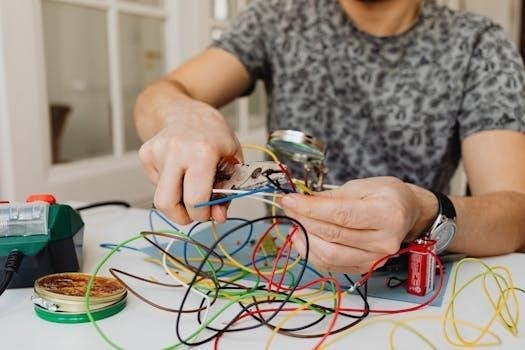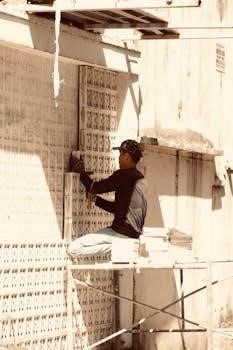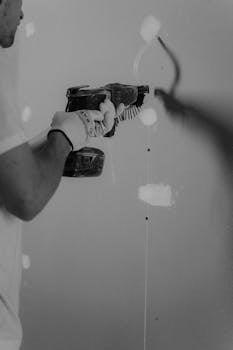
ditra-heat thermostat installation manual
The Ditra-Heat system offers a great way to warm tile floors, providing comfort and luxury․ This guide will assist in understanding the process of thermostat installation․ It is crucial for proper operation․
Overview of the Ditra-Heat System
The Ditra-Heat system is designed for warming tile, stone, and ceramic floors, using electric heating cables embedded in a specialized uncoupling membrane․ This system integrates with a thermostat to control the temperature, providing efficient and comfortable warmth․ The Ditra-Heat membrane allows for the heating cables to be installed without the need for traditional embedded wiring․ This reduces installation time and complexity․ The system is versatile and can be used in various areas, including bathrooms, kitchens, and living spaces․ It is important to note that the Ditra-Heat system requires a compatible thermostat for proper operation․ Installation involves laying the membrane, embedding the heating cables, and then connecting to the thermostat․ This ensures even heat distribution across the floor․

Wiring Basics
Understanding the wiring is crucial for a safe and functional Ditra-Heat system․ This section covers connecting heating cables, the temperature sensor, and grounding considerations․
Connecting the Heating Cables
When connecting the Ditra-Heat heating cables to the thermostat, ensure power is disconnected at the breaker․ The cables are connected to designated terminals on the thermostat, typically labeled for heating․ Carefully insert the cable wires into the appropriate terminals, making certain that the connection is secure․ Tighten the screws to prevent any loose connections, which can lead to system malfunction․ It’s crucial to consult the manufacturer’s specific wiring diagram to avoid any mistakes in the connection process․ Proper connection is vital for efficient and reliable operation of the floor heating system․ Always double-check your work to ensure all connections are firmly in place before applying power to the system․
Wiring the Floor Temperature Sensor
The floor temperature sensor is crucial for accurate temperature control within the Ditra-Heat system․ When wiring, locate the terminals specifically for the sensor, often marked “C” and “D” on the thermostat․ The sensor wires do not have polarity, so either wire can go to either terminal․ Insert the sensor wires into the designated terminals and securely tighten the screws to ensure a stable connection․ Proper sensor placement is vital for accurate temperature readings; ensure it is positioned between heating cables, away from walls, and not overlapping any cables․ Take care not to damage the sensor when placing it․ Secure and correctly wired sensor is essential for the thermostat to function correctly․
Grounding Considerations
Proper grounding is an essential safety measure when installing any electrical system, including the Ditra-Heat system․ Grounding ensures that in the event of a fault, electricity will safely divert away from the user, minimizing the risk of electrical shock․ Connect the ground wire from the power source to the designated ground terminal on the thermostat․ This connection is usually indicated with a ground symbol․ Ensure the grounding connection is firm and secure for optimal safety․ A properly grounded system will also protect the electronic components from surges or other electrical anomalies․ Always consult local electrical codes․ If you are unsure about grounding procedures, seek advice from a qualified electrician․

Thermostat Placement
Proper thermostat placement is key for accurate temperature readings and optimal system performance․ Consider factors like drafts, sunlight, and heat sources when selecting the location․
Optimal Location for the Thermostat
Selecting the ideal spot for your Ditra-Heat thermostat is crucial for accurate temperature regulation and efficient system operation; The thermostat should be placed in a location where it can accurately sense the ambient room temperature, avoiding areas that might skew readings․ This includes areas near windows, doors, or exterior walls where drafts might occur․ A central interior wall is often the most suitable option․ It is recommended to avoid direct sunlight or other heat sources, like radiators or appliances, as they could cause the thermostat to misinterpret the room’s actual temperature․ The thermostat should be positioned at a comfortable height for easy access and visibility․ It should be easily accessible for adjustments and programming while also being out of the way of accidental bumps or interference․ The specific height will depend on the room and user preferences․ The placement should be considered in conjunction with the floor sensor placement for a balanced system․
Thermostat Placement in Wet Environments
When installing a Ditra-Heat system in wet areas, such as bathrooms or wet rooms, it is important to carefully consider the placement of the thermostat to ensure safety and optimal performance․ The thermostat should always be installed in compliance with local electrical codes and regulations․ It should be located away from direct contact with water sources, such as showers, bathtubs, or sinks, to prevent the risk of electrical shock․ It is advisable to position the thermostat outside the direct splash zone of these areas․ Consider using a suitable waterproof box or enclosure for the thermostat if it needs to be positioned in a potentially damp area․ Ensure that the thermostat is not placed in a location where it might be subjected to excessive moisture or humidity, as this can damage the device and affect its functionality․ The thermostat should still be easily accessible and visible for adjustments․
Avoiding Heat Sources and Drafts
When selecting a location for your Ditra-Heat thermostat, it’s crucial to avoid placing it near heat sources or drafts․ Positioning the thermostat too close to direct sunlight, radiators, or other heating appliances can lead to inaccurate temperature readings․ This will result in the system not heating your floor properly․ Similarly, avoid placing the thermostat in drafty areas, such as near doors, windows, or air vents․ Drafts can cause the thermostat to sense lower temperatures than the actual room temperature․ This will make the system work harder than necessary, consuming more energy․ The thermostat should be mounted on an interior wall in a location that is representative of the average room temperature․ A central location free from both direct heat and drafts is ideal for accurate temperature regulation and optimal performance․ This ensures consistent and efficient heating․

Specific Thermostat Models
Schluter offers various thermostat models, including the DITRA-HEAT-E-RT and the DITRA-HEAT-E-RS1 Smart WiFi Thermostat․ Each model has unique connection methods detailed in user guides․
DITRA-HEAT-E-RT Thermostat Connection
The DITRA-HEAT-E-RT thermostat connection method is consistent with other current Schluter models, simplifying the wiring process․ For detailed instructions, always refer to the Schluter user guides or the installation handbook․ These resources provide comprehensive diagrams and step-by-step directions to ensure proper and safe installation․ The connection involves securing the heating cable wires, the floor temperature sensor wires, and the power supply wires to the designated terminals on the thermostat’s backplate․ The floor sensor wires, which have no polarity, should be connected to terminals C and D․ Tightening the screws correctly is vital to secure all connections․ The power connections require careful attention to ensure proper voltage and a secure ground connection for safety and optimal performance․ These connections should be made according to local electrical codes․
DITRA-HEAT-E-RS1 Smart WiFi Thermostat
The DITRA-HEAT-E-RS1 is a smart thermostat offering advanced features like WiFi connectivity and third-party integration․ This model allows for remote control and scheduling of your floor heating system, enhancing convenience and energy efficiency․ Connecting the DITRA-HEAT-E-RS1 involves similar wiring steps as the DITRA-HEAT-E-RT, including connecting the heating cables, floor sensor, and power supply to the backplate terminals․ The key difference lies in its smart capabilities, which require connecting to a WiFi network for remote access via a smartphone or other devices․ Setting up the WiFi connection and using its smart features should be done by following the manufacturer’s instructions closely․ This model also often requires pairing with a smartphone app․ The DITRA-HEAT-E-RS1 offers modern convenience and precise temperature control of your floor heating system․

Troubleshooting and Alternatives
This section addresses common issues, such as wiring pitfalls, and explores alternatives to Schluter thermostats․ It also provides guidance on using non-Schluter thermostats with the Ditra-Heat system․
Using Non-Schluter Thermostats
While Schluter provides specific thermostats for their Ditra-Heat system, some users may explore using alternative thermostats․ It’s essential to proceed with caution and ensure compatibility when considering non-Schluter options․ Before attempting to use a third-party thermostat, carefully review the specifications of the Ditra-Heat system and the chosen thermostat․ Pay close attention to voltage, current, and resistance requirements to prevent damage or malfunction․ Confirm that the third-party thermostat has the necessary features for controlling floor heating, such as sensor input and temperature regulation․ Be aware that using a non-Schluter thermostat may void the warranty on the Ditra-Heat system․ If you are unsure about compatibility, it is highly recommended to consult with a qualified electrician or contact Schluter customer support for guidance․ Seeking professional advice will help ensure safe and effective operation of your floor heating system․
Common Wiring Pitfalls
When installing a Ditra-Heat system, several wiring pitfalls can lead to issues․ One common mistake is neglecting to properly ground the system, which is crucial for safety․ Incorrectly connecting the heating cables to the thermostat can result in the system not functioning, or worse, causing damage․ Another pitfall involves misidentifying the sensor wires, which are for temperature regulation; their polarity does not matter, but they must go in the right terminals․ Ensure all connections are secure and screws are tightly fastened, avoiding loose wires․ Failing to adhere to the manufacturer’s specifications and instructions can also cause problems․ Always double-check wiring diagrams and consult the user manual․ Overlooking voltage and current requirements could cause damage to the components․ Finally, improperly placing the sensor can lead to inaccurate temperature readings․ Paying close attention to these details will ensure your system works correctly and safely․
Additional Resources
For detailed guidance, refer to Schluter’s user manuals and handbooks․ The Schluter-DITRA-HEAT-E-RRS power module is also recommended for optimal performance and compatibility with the system․
Referencing Schluter User Guides and Handbooks
When embarking on the installation of your Ditra-Heat system, it’s imperative to consult the official Schluter user guides and handbooks․ These resources provide detailed step-by-step instructions, diagrams, and safety information crucial for a successful installation․ The user guides offer specific details on the connection methods for different Ditra-Heat thermostat models․ They ensure that you follow the correct procedures for connecting the heating cables, the floor temperature sensor and the power supply․ These comprehensive documents also contain troubleshooting tips and address common installation challenges․ By thoroughly reviewing these materials, you will be well-equipped to handle most situations that may arise during the installation․ It’s essential to always prioritize these official documents over general online advice․
Power Module Recommendations
For optimal performance and safety, it is essential to select the correct power module for your Ditra-Heat system․ Schluter specifically recommends the DITRA-HEAT-E-RRS power module for use with their systems, particularly for the DITRA-HEAT-E-RS1 Smart WiFi thermostat․ This module is designed to provide the necessary power and control for your heated floor․ Using a non-recommended power module may result in operational issues or damage to the system․ It is important to verify the compatibility of any power module with your chosen thermostat and heating cables․ The Schluter documentation outlines the appropriate use cases for each module, ensuring a safe and efficient installation․ Always adhere to these recommendations to avoid any potential complications․